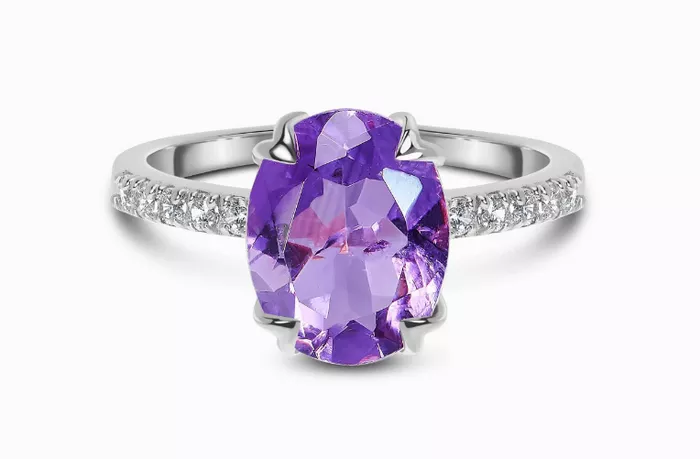Amethyst, known for its mesmerizing purple hues ranging from delicate lilacs to deep violets, has captivated jewelry enthusiasts for centuries. As a member of the quartz family, this gemstone possesses unique qualities that make it a popular choice for various types of jewelry, including rings. However, concerns often arise about its durability and suitability for everyday wear. This comprehensive article explores the characteristics of amethyst, its hardness on the Mohs scale, factors influencing its durability, and practical considerations when choosing an amethyst ring.
Introduction to Amethyst
Amethyst is a semi-precious gemstone prized for its vibrant color and clarity. It derives its distinctive purple hues from trace amounts of iron within its crystal structure. Found in geodes and alluvial deposits worldwide, notable sources include Brazil, Uruguay, Zambia, and Russia. Beyond its aesthetic appeal, amethyst is often associated with qualities such as tranquility, protection, and spiritual enlightenment, adding to its allure in jewelry.
Understanding Mohs Hardness Scale
The Mohs scale of mineral hardness measures a gemstone’s resistance to scratching and abrasion. It ranks minerals from 1 (softest) to 10 (hardest), with each increment representing a higher level of hardness. This scale is crucial in evaluating a gemstone’s durability and suitability for different types of jewelry, including rings:
1-2: Very soft (e.g., talc)
3: Soft (e.g., calcite)
4: Medium (e.g., fluorite)
5: Medium to hard (e.g., apatite)
6-7: Hard (e.g., orthoclase feldspar, quartz)
8-10: Very hard to hardest (e.g., topaz, sapphire, diamond)
Amethyst falls into the category of quartz, which ranks 7 on the Mohs scale. This places it alongside other well-known gemstones like citrine and ametrine, which are also varieties of quartz. While a hardness of 7 signifies that amethyst is relatively durable, it is essential to understand how this translates into practical considerations for ring wear.
Factors Affecting Amethyst’s Durability in Rings
Several factors influence the durability and longevity of an amethyst ring:
Hardness and Resistance to Scratching:
Amethyst’s hardness of 7 means it is resistant to scratches from everyday wear, including activities that may expose the ring to surfaces like desks, countertops, or other jewelry. However, it can still be scratched by harder materials such as sapphire or diamond, so care should be taken to avoid contact with these substances.
Brittleness and Susceptibility to Fractures:
Despite its hardness, amethyst can be brittle compared to other gemstones like sapphire or ruby. This means it may be more prone to chipping or fracturing if subjected to sharp impacts or sudden temperature changes. Protective settings and careful handling can mitigate these risks.
Ring Setting and Design:
The setting of an amethyst ring plays a significant role in its durability. Settings that provide ample protection to the gemstone, such as bezel settings or halo settings, can shield the edges of the amethyst from impact and reduce the risk of damage. Prong settings, while popular for showcasing the gemstone, expose more of the stone and may require more careful handling.
Wearing Frequency and Lifestyle:
Consider your lifestyle and daily activities when deciding on an amethyst ring. Rings worn daily, especially in rigorous environments or during physical activities, may experience more wear and tear. If you lead an active lifestyle, you may prefer a more durable gemstone like diamond or sapphire for an engagement or everyday ring.
See Also: Is Engagement Ring More Expensive Than Wedding Ring?
Care and Maintenance:
Proper care and maintenance are essential for preserving the beauty and integrity of an amethyst ring. Avoid exposure to harsh chemicals, extreme temperatures, and ultrasonic cleaners that can damage the gemstone or its setting. Clean amethyst rings regularly with mild soap and warm water using a soft brush to remove dirt and oils.
Practical Considerations for Choosing an Amethyst Ring
When selecting an amethyst ring, keep these practical considerations in mind to ensure its durability and suitability:
Ring Design and Setting Type:
Opt for ring designs that prioritize the protection of the amethyst gemstone. Bezel settings completely encircle the gemstone with metal, offering maximum security against impact and wear. Halo settings surround the center stone with smaller diamonds or gemstones, providing additional support and enhancing the overall aesthetic.
Gemstone Size and Cut:
Larger amethyst gemstones may be more susceptible to damage due to their increased surface area. Consider a size that balances aesthetic appeal with practicality for everyday wear. Choose well-cut gemstones that maximize brilliance while minimizing potential weak points.
Certification and Quality Assurance:
Purchase amethyst rings from reputable jewelers who provide certifications of gemstone authenticity and quality. Certifications from recognized gemological laboratories such as GIA (Gemological Institute of America) or AGS (American Gem Society) ensure that the amethyst meets industry standards for color, clarity, and cut.
Personal Style and Preference:
Ultimately, your choice of an amethyst ring should align with your personal style, preferences, and the significance of the gemstone to you. Whether you are drawn to amethyst for its symbolic meaning, spiritual properties, or simply its captivating color, select a ring that resonates with you and brings joy.
Conclusion
Amethyst’s hardness of 7 on the Mohs scale makes it a durable and suitable gemstone for rings, provided it is worn and cared for appropriately. While it may not be as hard as sapphire or diamond, amethyst offers excellent durability for everyday wear when set securely and handled with care. By understanding the factors that influence amethyst’s durability, choosing the right ring design and setting, and practicing proper maintenance, you can enjoy the beauty and allure of an amethyst ring for years to come. Whether as an engagement ring, a statement piece, or a cherished gift, an amethyst ring serves as a timeless symbol of elegance and individuality in jewelry.

